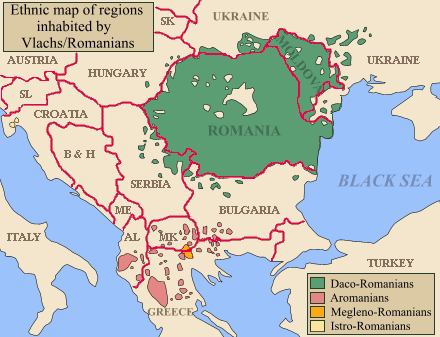
Back Llingües balcorrumanes AST Common Romanian English Lenguas balcorrumanas Spanish Proto-roumain French Protoromán nyelv Hungarian Bahasa Proto-Rumania ID Język prarumuński Polish Língua protorromena Portuguese Limba protoromână Romanian Проторумынский язык Russian
'Proto-rumanishtja' (i njohur edhe si "rumunishtja e rendomte", Româna comunăose "rumanishtja e lashtë ",străromâna) është hipotetikisht Gjuha qe konsiderohet të ketë qenë thënë nga paraardhësit e [sotme [rumunë]] dhe popujtlatine teBallkanit si (vllehët), midis shek 7 dhe 9.

Proto-rumune tashmë kishte një strukturë shumë e dallueshme nga gjuhët Romance të tjera, me dallime të mëdha në gramatikë, morfologji dhe fonologji dhe tashmë ishte një anëtar i [bashkimit [gjuhësore ballkanike]]. Shumica e karakteristikat e tij mund të gjenden në gjuhët moderne Lindore Romance. Ajo tashmë përmbante rreth njëqind kredi nga gjuhët sllave, duke përfshirë fjalë të tilla si "trup" (trup), si edhe disa kredi gjuhën greke me vulgar Latin, por asnjë fjalë hungarez.
Ajo ishte thyer në gjuhët e mëposhtme moderne dhe dialektet e tyre:
- Romanian language (sometimes called Daco-Romanian to distinguish it from the rest of the Eastern Romance languages)
- Aromanian
- Megleno-Romanian
- Istro-Romanian
The first language that broke the unity was Aromanian, in the 9th century, followed shortly after by Megleno-Romanian. Istro-Romanian was the last to break the link with Daco-Romanian in the 11th century.
The place where Proto-Romanian formed is still under debate; most historians put it just to the north of the Jireček Line. See: Origin of Romanians.
The Roman occupation led to a Roman-Thracian syncretism, and similar to the case of other conquered civilisation (see Gallo-Roman culture developed in Roman Gaul), had as final result the Latinization of many Thracian tribes which were on the edge of the sphere of Latin influence, eventually resulting in the possible extinction of the Daco-Thracian language (unless, of course, Albanian is its descendant), although traces of it are still preserved in the Eastern Romance substratum. Starting from the second century AD, the Latin spoken in the Danubian provinces starts to display its own distinctive features, separate from the rest of the Romance languages, including those of western Balkans (Dalmatian).[1] The Thraco-Roman period of the Romanian language is usually delimited between the 2nd (or earlier, via cultural influence and economic ties) and the 6th or 7th century.[2] It is divided, in turn, into two periods, with the division falling roughly in the 3rd-4th century. The Romanian Academy considers the 5th century as the latest date when the differences between Balkan Latin and western Latin could have appeared [3], and that between the 5th and 8th centuries, this new language – Romanian - switched from Latin speech, to a neolatine vernacular idiom, called Română comună.[4][5]
- ^ Al. Rosetti: “Istoria limbii române” ("History of the Romanian Language"), Bucharest, 1986
- ^ Dicţionarul limbii române (DLR), serie nouă ("Dictionary of the Romanian Language, new series"), Academia Română, responsible editors: Iorgu Iordan, Alexandru Graur, Ion Coteanu, Bucharest, 1983;
- ^ “Istoria limbii române” ("History of the Romanian Language"), II, Academia Română, Bucharest, 1969;
- ^ I. Fischer, “Latina dunăreană” ("Danubian Latin"), Bucharest, 1985.
- ^ A. B. Černjak “Vizantijskie svidetel’stva o romanskom (romanizirovannom) naselenii Balkan V–VII vv; “Vizantinskij vremmenik”, LIII, Moscova, 1992
© MMXXIII Rich X Search. We shall prevail. All rights reserved. Rich X Search
